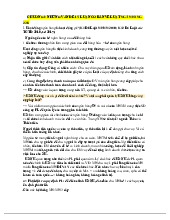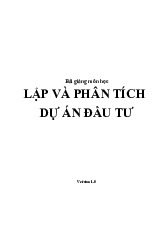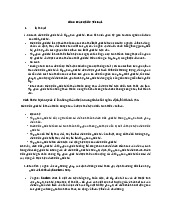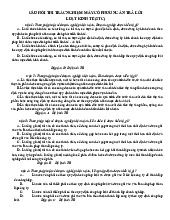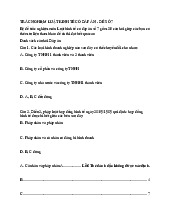










Preview text:
lOMoARcPSD| 38777299
NATIONAL ECONOMICS UNIVERSITY -------- ASSIGNMENT BUSINESS LAW TOPIC:
LAW AND LEGAL REASONING
Student’s name: Dinh Ngoc Minh Duc Vu Anh Duc Dao Binh Minh Nguyen Khoi Nguyen Class: Advanced Finance 64D Lecturer: Dr. Tran Van Nam Ha Noi, November 2023 lOMoARcPSD| 38777299 TABLE OF CONTENTS
I. GENERAL KNOWLEDGE ................................................................................ 3
1. Precedent Explanation ........................................................................................ 3
2. Case law Explanation ......................................................................................... 3
3. Finding Case Law ............................................................................................... 4
a) Introduction to the U.S. Court System: ........................................................... 4
b) State Court Decisions: ..................................................................................... 4
c) Citation of Appellate Decisions: ..................................................................... 4
d) Regional Units and National Reporter System: .............................................. 4
e) Federal Court Decisions: ................................................................................. 4
f) Unpublished Opinions and Old Cases: ............................................................ 5
II. CASE 1-7. The Doctrine of Precedent (United States v. White) .................... 5
1. Case Summary ..................................................................................................... 5
2. Court’s Opinion .................................................................................................. 6
3. Analysis .............................................................................................................. 6
a) Standard of Review ......................................................................................... 6
b) Defining “Use” Pursuant to 18 U.S.C. § 1028A ............................................. 7
3. Court’s decision and ethical perspective ............................................................ 7
III. RELATED TO VIETNAM .............................................................................. 8
1. Legal frame work in Vietnam ............................................................................. 8
2. Process of selecting, publishing and applying case law in Viet Nam ................ 8
a) Criteria for selecting case law ......................................................................... 9
b) Applying precedent in trial ............................................................................. 9
c) Resolution 04/2019/NQ-HDTP on the process of selecting, publishing and 9
applying precedents ............................................................................................. 9
3. Challenges in the Current Application of Legal Precedents in Vietnam ......... 10
IV. REFERENCE..................................................................................................13 lOMoARcPSD| 38777299 I. GENERAL KNOWLEDGE
1. Precedent Explanation
Precedent or stare decisis is a principle or rule established in a previous legal case
relevant to a court or other tribunal when deciding subsequent cases with similar
issues or facts. Common-law legal systems often view precedent as binding or
persuasive, while civil law systems do not. Common-law systems aim for similar
facts to yield similar and predictable outcomes, and observing precedent when
making decisions is the mechanism to achieve that goal. Common-law precedent is
a third kind of law, on equal footing with statutory law (that is, statutes and codes
enacted by legislative bodies) and subordinate legislation (that is, regulations
promulgated by executive branch agencies, in the form of delegated legislation) in
UK parlance – or regulatory law (in US parlance). The principle by which judges
are bound to precedents is known as stare decisis (a Latin phrase with the literal
meaning of "to stand in the things that have been decided").
The doctrine of precedent is the custom of the courts to stand by previous
decisions, so that once a point of law is decided upon by a court, then the same law
must be applied to future cases with materially similar facts.
2. Case law Explanation
Case law, also used interchangeably with common law , is law that is based on
precedents, that is the judicial decisions from previous cases, rather than law
based on constitutions , statutes , or regulations . Case law uses the detailed facts
of a legal case that have been resolved by courts or similar tribunals . These past
decisions are called "case law", or precedent. Stare decisis—a Latin phrase
meaning "let the decision stand"—is the principle by which judges are bound to
such past decisions, drawing on established judicial authority to formulate their positions.
These judicial interpretations are distinguished from statutory law , which are
codes enacted by legislative bodies , and regulatory law , which are established by
executive agencies based on statutes. In some jurisdictions, case law can be applied
to ongoing adjudication ; for example, criminal proceedings or family law. lOMoARcPSD| 38777299
In common law countries (including the United Kingdom , United States ,
Canada , Hong Kong, Singapore , Australia and New Zealand ), it is used for
judicial decisions of selected appellate courts , courts of first instance , agency
tribunals, and other bodies discharging adjudicatory functions. 3. Finding Case Law
a) Introduction to the U.S. Court System:
Before delving into the case reporting system, it's essential to briefly understand
the structure of the U.S. court system, encompassing federal and state courts. Both
systems involve multiple tiers, with trial courts at the bottom, handling evidence
and testimony. Appeals from trial courts can ascend through intermediate courts to
the highest levels, such as state supreme courts or the United States Supreme Court.
b) State Court Decisions:
- Trial Court Decisions: Most state trial court decisions are not published, except in a few states like New York.
-Appellate Court Decisions: Decisions from state appellate courts are published in
volumes known as reports or reporters. State appellate court decisions are also part
of the National Reporter System, often used widely due to its accessibility.
c) Citation of Appellate Decisions:
After publication, appellate decisions are cited by the name of the case, volume,
name, and page number of the state's official reporter and the National Reporter.
Parallel citations are used when multiple reporters are involved. Example:
"Ramirez v. Health Net of Northeast, Inc., 285 Conn. 1, 938 A.2d 576 (2008)."
d) Regional Units and National Reporter System:
- The National Reporter System categorizes states into regions (e.g.,
Atlantic, North Eastern) and provides a regional breakdown.
e) Federal Court Decisions:
- Federal district court decisions are unofficially published in West’s Federal Supplement.
- Circuit court opinions are unofficially reported in West’s Federal Reporter. lOMoARcPSD| 38777299
- Federal bankruptcy cases are unofficially reported in West’s Bankruptcy
Reporter.- The United States Reports is the official edition for U.S. Supreme Court decisions.
f) Unpublished Opinions and Old Cases: -
Unpublished opinions or those not intended for publication can be accessed through Westlaw. -
Old cases, occasionally cited, may have non-conforming citations due to replacedreporters.
This breakdown highlights the key components of the passage, providing a clearer
understanding of the process of finding and citing case law in the U.S.
II. CASE 1-7. The Doctrine of Precedent (United States v. White) 1. Case Summary
Sandra White and her husband Joseph White owned and operated a travel agency
named Corporate Travel Consultants (CTC) since 1989. In order to obtain low
airline fares for the agency's clients, White routinely booked military-rate travel for
her non-military-member clients by providing false information about her clients'
ages, possession of various discount certificates, and military status. As a travel
agent, White could obtain additional revenue through commissions, service fees,
and additional bookings. White manufactured fake military identification cards and
sent them to the airlines as alleged proof of her clients' military credentials. The
airlines suspected that the military identification cards were forged because a
suspicious number of her clients are military personnel and contacted investigators.
Additionally, at trial, it has been revealed that she charged service fees and other
airfare directly to her client's credit cards, sometimes for persons other than those
specific clients, and sometimes without their permission. The trial court considered
two precedent cases. In one case, David Miller falsely claimed to have his investor
approved to buy a loan when they didn't . In the other case, Kathy Medlock who
work as an ambulance service operator had falsely used the ambulance to transport
patients that didn't have the medical necessity to do so. She had been making
counterfeit copies of a physician’s signature in order to obtain payment [United
States v. White, 846 F.3d 170 (6th Cir. 2017)].2. In the Words of the Court lOMoARcPSD| 38777299 2. Court’s Opinion
Sandra White (“White”) and her husband Joseph White operated a travel agency.
In order to obtain low airline fares for the agency's clients, White routinely booked
military-rate travel for her non-military-member clients. When airlines became
suspicious of White's practices, and asked her for proof of her clients' military
status, White manufactured fake military identification cards and sent them to the
airlines as alleged proof of her clients' military credentials. The airlines suspected
that the military identification cards were forged and contacted investigators. After
a jury trial, White was convicted of mail fraud and aggravated identity theft, and
sentenced to a total of ninety-four months of imprisonment.
White now challenges her conviction and sentence on the basis that (1) the district
court read an improper definition of the term “use” into the aggravated identity
theft statute; (2) the district court abused its discretion in refusing to admit certain
evidence of White's intention to repay some of the airlines' losses; and (3) the
district court erred in calculating the amount of White's victims' losses. For the
reasons set forth below, we AFFIRM the judgment of the district court. 3. Analysis
a) Standard of Review
• Statutory Construction: Whether the district court correctly interpreted
"uses" in 18 U.S.C. § 1028A is a statutory construction issue. Statutory
interpretation is reviewed de novo. (United States v. Miller, 734 F.3d 530,
539, 2013) Also, the denial of a motion to dismiss the indictment is subject
to de novo review. (United States v. Ali, 557 F.3d 715, 720, 2009)
• Evidentiary Rulings: Evidentiary rulings by the district court are reviewed
for abuse of discretion. Abuse of discretion occurs when there are clearly
erroneous findings, improper application of the law, or use of an erroneous
legal standard. (United States v. Freeman, 730 F.3d 590, 595, 2013)
• Amount of Loss Calculation: The district court's calculation of the
"amount of loss" is reviewed for clear error, but the methodology behind it is
considered de novo. The court must determine the amount of loss by a
preponderance of the evidence, and findings should not be overturned unless
clearly erroneous. (United States v. Meda, 812 F.3d 502, 519, 2015; United lOMoARcPSD| 38777299
States v. McCarty, 628 F.3d 284, 290, 2010) To challenge this calculation,
the defendant must demonstrate that the evaluation was not only inexact but
outside the acceptable universe of computations. (United States v. Martinez, 588 F.3d 301, 326, 2009)
b) Defining “Use” Pursuant to 18 U.S.C. § 1028A
Defendant Sandra White challenges her conviction of aggravated identity theft
under 18 U.S.C. § 1028A, arguing that the district court incorrectly applied
precedent. The statute criminalizes knowingly transferring, possessing, or using,
without lawful authority, a means of identification of another person during a
felony violation. White was accused of using the names of individuals, for whom
she fraudulently obtained military fares, to manufacture fake Armed Forces
Identification Cards. She then sent these cards to airlines in an attempt to justify
previously obtained reduced fares during her wire fraud scheme.
White contends that the court misapplied United States v. Miller (2013) and United
States v. Medlock (2015). In Miller, the defendant's conviction was reversed
because, as a matter of law, he did not "use" a means of identification by signing a
document falsely claiming authority from others. Medlock similarly emphasized a
narrow interpretation of "use" and concluded that misrepresentations about the
defendants' own eligibility for reimbursement did not constitute using others' identities.
The court distinguishes White's case, emphasizing her creation of fraudulent
military identification cards submitted to airlines. Unlike Miller and Medlock,
where the defendants lied about their actions, White submitted false identification
documents on behalf of others. The court concludes that White's actions,
particularly forging military identification cards and attempting to pass them off as
clients' means of identification, fall within the statute.
3. Court’s decision and ethical perspective
White’s actions most closely resemble Medlock’s forgery. White not only told the
airlines that her clients were members of the military—she created false
identification cards and sent them to the Airlines. After a jury trial, White was
convicted of mail fraud and aggravated identity theft, and sentenced to a total of
ninety-four months of imprisonment. lOMoARcPSD| 38777299
In all of these cases, the defendants engaged in dishonest conduct by lying about
their actions. Regardless of whether their actions aligned with statutory definitions
or matched those of other offenders, none of these parties can be considered to
have acted ethically, as honesty is a fundamental component of ethical behavior in
any context. In the actual case on which this problem is based, the court concluded
that White’s actions were most similar to Medlock’s.
Consequently, White was convicted of identity theft. On appeal, the U.S. Court of
Appeals for the Sixth Circuit affirmed the conviction.
III. RELATED TO VIETNAM
1. Legal frame work in Vietnam
The term “precedent” was officially defined in the Judicial Council’s Resolution
03/2015/NQ-HĐTP dated October 28, 2015, as follows:
“Precedent is legal reasoning and rulings in a legally effective judgment or
decision of a court on a specific case selected by the Judicial Council of the
Supreme People’s Court and announced by the Chief Justice of the Supreme
People’s Court as precedent for courts to study and apply in adjudication”.
In general, a precedent is an adjudicated case or decision of a court of justice that
provides a rule or authority for determining an identical or a similar case arising
subsequently. The theory on which it is possible for one decision to be an authority
for another is either that the facts are alike or that, if the facts are different, the
principle that governed the first case is applicable to the variant facts[4].
Subsequently, the Political Bureau’s Resolution 49/NQ-TW dated June 2, 2005,
also provided: “The Supreme People’s Court has the task of summarizing trial
experience, guiding the uniform application of the law, and developing precedents”.
2. Process of selecting, publishing and applying case law in Viet Nam
The 2015 Civil Code (Article 6), the 2015 Civil Procedure Code (Article 4 and
Article 45.3), and the 2015 Administrative Procedure Law (Article 191.3) all have
provisions on principles of application of and reference to precedents in the judicial lOMoARcPSD| 38777299
decision-making process. These legal grounds back the process of using precedents
as a source of law in the Vietnamese legal system in the context of judicial reform.
a) Criteria for selecting case law
Selected case law must meet the following criteria:
- Has the value of clarifying legal provisions that have different understandings,
analyzing and explaining legal issues and events, and pointing out the principles,
handling methods, and legal norms that need to be applied in the law. a specific
case or demonstrating fairness for issues that do not have specific laws; - Have standards;
- Has the value of guiding the uniform application of law in trials.
b) Applying precedent in trial 1.
Precedents are studied and applied in trial after 30 days from the date of publication. 2.
During the trial, judges and jurors must research and apply precedents to
ensure that cases with similar legal situations are resolved equally. In case the case
has similar legal situations but the Court does not apply the precedent, the reason
must be clearly stated in the Court's judgment or decision. 3.
In case the Court applies precedents to resolve the case, the number, name of
theprecedent, legal situations, legal solutions in the precedents, and legal situations
of the case being resolved must be cited. , analyzed in the “Court's Comments”
section; Depending on each specific case, all or part of the content of the precedent
can be quoted to clarify the Court's viewpoint in adjudicating and resolving similar cases.
c) Resolution 04/2019/NQ-HDTP on the process of selecting, publishing and
applying precedents
This resolution clearly outlines the construction and application of precedents in
the legal system of Vietnam. Accordingly, a precedent is considered the reasoning
and judgment of the Supreme People's Court on a specific case. To ensure the
quality and transparency of the precedent, criteria for selection are specified,
including clarifying legal provisions, ensuring standards, and providing uniform legal guidance.
Individuals and organizations have the right to propose precedents, providing
arguments, judgments, and meeting the specified criteria. The precedent is lOMoARcPSD| 38777299
announced, and opinions are sought within 30 days to gather evaluations and
feedback from the legal community, experts, and other relevant parties.
Most importantly, the Precedent Advisory Council, established under the
chairmanship of the President of the Supreme People's Court Scientific Council, is
responsible for discussing and providing formal opinions on the precedent. The
process of passing through a precedent is carried out through the decision of the
Supreme People's Court Council, ensuring transparency and quality in the
construction and application of precedents.
Subsequent steps include publication, application of the precedent in trials, and the
procedure for revoking the precedent when there are changes in the law or when
the precedent is no longer suitable. This way, the legal system ensures consistency
and fairness in the trial process, while enhancing the transparency and credibility of the legal procedure.
3. Challenges in the Current Application of Legal Precedents in Vietnam
Insufficient Number of Precedents: The number of legal precedents in Vietnam
is relatively low, currently standing at 70 published precedents. This figure is
inadequate compared to the annual number of verdicts and decisions issued by
courts at all levels (1.307.383 cases). The scarcity of legal precedents poses
difficulties in resolving civil cases, especially those lacking specific legal provisions.
Inconsistent Citation Methods: The method of citing legal precedents in verdicts
and decisions lacks uniformity nationwide. While most judges refer to precedents
in the reasoning section, some judges cite them in the decision section, leading to inconsistencies in practice.
Unclear Guidelines in Resolution 04/2019/NQ-HDTP: The guidelines in
Resolution 04/2019/NQ-HDTP regarding the application of legal precedents are
not clear, particularly in terms of determining what constitutes "similar legal
situations." The lack of specific guidance results in subjective interpretations by judges during application.
Low Legal Effectiveness of Precedents: The legal effectiveness of precedents is
still lower compared to other legal sources. Although legal precedents are supposed
to be applied when there is no applicable statutory provision or established
practice, their application is not always straightforward. The question arises lOMoARcPSD| 38777299
whether, in cases with both established practice and legal precedents, the court is
obliged to cite the precedent.
Lack of Formal Legal Interpretation Authority: The current legal framework
does not grant formal authority to the courts for legal interpretation. While courts
analyze and interpret legal provisions during the application process, there is no
formal legal interpretation authority. The absence of this authority contributes to
challenges in applying the law consistently. IV. REFERENCE
1. Miller & Cross (2021), The Legal Environment Today, (10th edn.) Cengage
2. UNITED STATES OF AMERICA v. SANDRA MAXINE WHITE (2017) .
(n.d.). https://caselaw.findlaw.com/court/us-6th-circuit/1765656.html
3. Nghị quyết 04/2019/NQ-HĐTP về quy trình lựa chọn công bố và áp dụng án lệ
(2019). (n.d.). https://thuvienphapluat.vn/van-ban/Thu-tuc-To-tung/Nghi-quyet-
042019-NQ-HDTP-ve-quy-trinh-lua-chon-cong-bo-va-ap-dung-an-le-293168.aspx
4. Associate Professor, PhD. NGUYỄN MINH TUẤN, Bàn về án lệ và việc
ápdụng án lệ ở Việt Nam (2022). (n.d.).
http://www.lapphap.vn/Pages/tintuc/tinchitiet.aspx?tintucid=210998
5. Sebastian Lewis, Precedent and the Rule of Law (2021). (n.d.).
http://www.lapphap.vn/Pages/tintuc/tinchitiet.aspx?tintucid=210998
